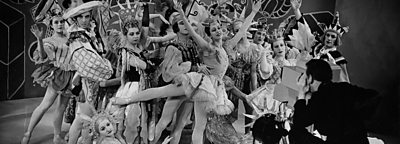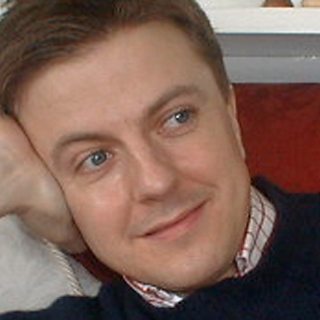Image: The Vic Wells Ballet company 'Casse-Noisette' perform for the cameras in March 1937.
±«Óãtv Archives recently digitised a selection of rarely seen still images taken during live transmissions from Alexandra Palace. They are presented here as a series of audio slideshows for the first time.
Women
Broadcasting was a predominantly male preserve in the 1920s, but by the mid-1930s women had started taking on a variety of roles in radio. Television followed a similar pattern, but there were some early moves by women into television, Mary Adams joined the television service in January 1937, becoming the ±«Óãtv’s first female television producer.
This sample of stills shows some of the TV programmes women took part in before ±«Óãtv Television closed down before the war.
War and News
Although pre-war television often consisted of light-hearted features and entertainment items, the ±«Óãtv’s remit as an educator was not forgotten, and as war loomed, the Television Service showed an increasing number of programmes devoted to preparations for war.
These included: ARP (Air Raid Precautions) demonstrations, how to protect your home in wartime, instruction from military personnel, military tactics using models, weapons capabilities, how to use a gas mask, and the changing political situation. But the tone did not change abruptly. Drama, comedy, and regulars such as Picture Page continued as normal until the outbreak of war forced the Service to close.
Picture Page
Picture Page was 'The very first television magazine programme in the world' (Joan Miller, 'The Switchboard Girl', 1936-1952). It was also one of the simplest programmes, its remit being to place people in front of the camera 'to be televised'. Such was the sheer novelty of the medium in the early years, it was enough to see before you a performance by a tap dancer or an interesting character or 'type' as they were sometimes referred to.
Joan Miller was its presenter, and she explained in 1976, how the programme worked, when looking back to her many years on the show.
Outside Broadcasts
Early Outside Broadcasts (OB's), were surprisingly ambitious affairs. Despite uncertainty about how cameras might react to conditions outside the carefully controlled conditions of the studio, camera engineers pushed the boundaries of the new medium within the first few months of ±«Óãtv Television becoming operational.
Initially cameras were sent out onto the terrace at Alexandra Palace at the end of long cables, directly connected to the Control Room, to televise visiting gatherings of animals from the London Zoo, air demonstrations, and gardening from the palace grounds.
Comedian Leonard Henry leaving the studios of Alexandra Palace on 5 September 1936 was the first outside broadcast, but this was seen as part of the demonstration schedule transmitted for public gatherings at the Radiolympia trade show. The first outside broadcast as part of the official regular ±«Óãtv Television Service, was Railway Demonstration, Saturday 6 March, 1937, 15.00.
Music at Alexandra Palace
±«Óãtv Television's first producer Cecil Madden was highly adept at booking musical 'acts' from London’s West End close to transmission, an idea that shocked the radio producers at Broadcasting House. Normally radio bookings were made weeks in advance, and the transmissions were painstakingly rehearsed.
Madden on the other hand did not have the luxury of a team of 'fixers' and instead sent out young talent scouts to book the latest musical hits from the shows. The result was a spontaneous selection of the weird and wonderful.
-
Cecil Madden and the early staff at Alexandra Palace spoke about day to day life at the studios in the very first issue of the Radio Times Television Number supplement, 23 October 1936.
The Birth of Television
Leslie Mitchell announced the official opening of the first high-definition public television service in the world an 2 November 1936. Forty years later, from the same studio at Alexandra Palace, he traced the origins of television from the beginning of the 20th century to the first outside broadcast - the Coronation of George VI in May 1937.
Starring Gracie Fields, Dinah Sheridan, Arthur Askey, Cyril Fletcher, with television's original presenters Jasmine Bligh, Elizabeth Cowell, Joan Miller, and Leslie Mitchell.
Cameraman: Bill Matthews, Sound Recordist: Bill Meekums, Costume Designer: Lisa Benjamin, Designers: Cary Pritchard and Dacre Punt, Film Editor: Ted Walter, Director: Laurie John, Written and Produced by: Bruce Norman.
Search by Tag:
- Women
- Mary Adams
- Picture Page
- Joan Miller
- ±«Óãtv Outside Broadcast Department
- Alexandra Palace
- Railway Demonstration
- Cecil Madden
- Birth of TV
- Birth of TV Picture Gallery
- Coronation of King George VI
- Gracie Fields
- Dinah Sheridan
- Arthur Askey
- Cyril Fletcher
- Jasmine Bligh
- Elizabeth Cowell
- Leslie Mitchell
- Bill Matthews
- Bill Meekums
- Lisa Benjamin
- Cary Pritchard
- Dacre Punt
- Ted Walter
- Laurie John
- Bruce Norman
- Voices of the ±«Óãtv

